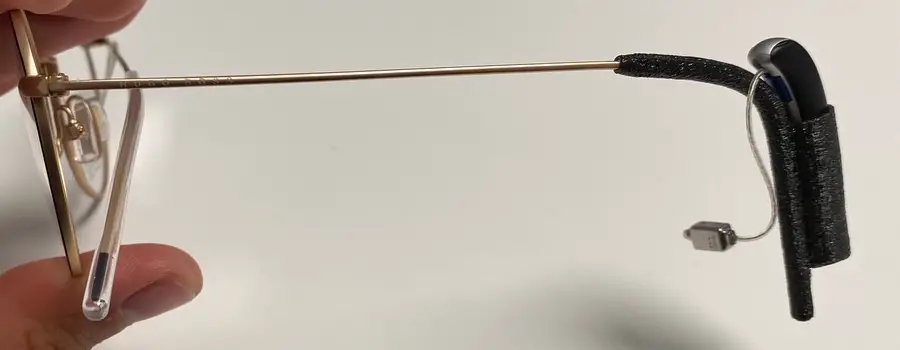There are different tactics you or your hearing aid professional could use to keep your hearing aids from falling out. Here in this article, you will find solutions whether your hearing aid falls off your ear or when it keeps falling out of your ear canal.
In some cases, the hearing aids or the earmold slips out. When this happens you should tell your hearing care professional about it. It is always useful for her or him to know in which situation it happened. He then will tell you which option to choose from this list.
One of the easiest and fastest ways to fix this issue is a little plastic adjustment called hearing aid retention cords. Read on to know the options for the next visit to your local audiologist.
Use Hearing Aid Retention Cords
Retention cords are thin, flexible plastic pieces that can be attached to the receiver/loudspeaker or tube of your hearing aid. This will add a little more pressure against your ear and acts as an effective anchor to make sure your hearing aid stays in your ears. They are available in different sizes which are specific to your hearing aid manufacturer.
In most cases a retention cord makes it more perceivable when the hearing aid slips out of your ear. Because of the little plastic band providing very little pressure in one direction the anchor effect is very low. The good thing is it takes practically no time to attach it to your hearing aid. That drawback is when the hearing aid just falls out of your ear this will probably not be the best solution for you.
Get the Right Length of the Tubes or Cables of Your Hearing Aids
The link between the piece which goes into your ear is and the part behind the ear of your hearing aids is a cable or a tube. When this link is too short or too long the fit gets more unstable and could fall out more easily. Tubes can be adjusted to every length imaginable. The cables are typically available in 3-5 lengths depending on the brand of your hearing aid.
When the cables/tubes are too short the hearing aid does not have optimal bearing behind your ear. This makes the hearing aids more prone to slip forward. When the pulling forces of the earmolld or domes are strong the hearing aid will than end up dangling beside your ear.
In contrast, when the domes or ear molds do not have the correct shape they will not stay perfectly in your ear. Instead of staying in one position, they will move a little out of your ear canal and in the end, fall out. This mostly happens when you talk or when you chew. With the movement of your jaw, the ear canal is also influenced a little. With the correct shape of a custom earmold this will not happen anymore. You can find out more about it in the next paragraph.
Get a New Custom Ear Mold With a Better Fit to Prevent Your Hearing Aids From Falling Out
A good custom earmold is a fa complex topic than you might think. We all have different shaped ear canals. When the ear canal is very straight the audiologist must take advantage of the anchoring options that are slightly more visible. Because the windings and filings of your need to be used to produce a stable fit.
When your ear canal is shaped very curved a very small custom ear mold might do the job just as good as a slightly bigger one in a straighter ear canal. Here in the next paragraph, you learn about the places where the custom earmold should fit in to prevent them from falling out.

Here in the picture above you can see the different shapes of ear molds. Starting from a very small shaped earmold on the left which uses solely the retention and holding forces from the ear canal to a ring shaped ear mold on the right.
Different shapes use different holding points of the auricle. With a different ear mold heat dissipation, easy insertion and removal is influenced. A ring on the right uses all the holding points of the auricle and reduces the likelihood of hearing aid falling out of your ear. But the ear is moves and gets oftentimes influenced a lot by the lower jar.
This means a custom ear mold which using all the holding points could still find its way out when the lower jar deforms the ear canal a lot. The next paragraphs will be dedicated to how the shape of the earmold needs to be changed to prevent this from happening.
Get a Cutout in Your Custom Earmold to Prevent Your Lower Jaw From Pushing the Hearing Aid Out
When the earmold finds it way out the shape is either not right missing the holding points of the auricle or the jaw is pressing it out. The lower jaw is located at the lower part slightly forward in your ear canal. It might make sense to cut out this part which leads to the the hearing aid falling out.
For the wearer this might not be very obvious. Even the acoustician or audiologist needs to use different methods in order to see how big the influence of the jaw really is. The common methods are:
- Making two ear molds with impression silicone one when the jaw is not moving and one chewing
- using haptic feedback / sticking a finger into the ear canal to get a sense where and how much the lower jar is moving
´With the information the silicone can then be directly cut out by the hearing care professional. He or she takes away a little material and then checks if the silicone impression moves less. I am a fan of checking the shape directly and changing the shape when necessary before the final earmold gets manufactured. This saves time and makes it easier to decide on the final shape of the earmold.
When the shape is not validated but instead the earmold is just ordered the likelihood will be much higher for the hearing aid finding its way out of the ear instead of staying in nicely.
Now that we discussed techniques for securing hearing aids in the right place in the ear let us talk about behind the ear and a uncommon way to produce a better fit.
Use a Piggyback System Prevent the Hearing Aid From Falling Out
Piggyback Systems for hearing aid utilize a different temple tip for glasses. Especially when a facemask for example is put on and off multiple times daily behind-the-ear hearing aids are very likely to lose their position. They then dangle beside the ears or fall out entirely. This happens because of the missing holding points for a behind-the-ear hearing aid.
There is not much behind the ear for the hearing aid to grab with its shape or to produce a tighter fit. But in the picture below for example you can see one of our piggyback systems which were designed for a customer who lost one of the hearing aids before.

With this piggy back system never the hearing aid just stays behind the ear. But of course depending on how big the ears are this can be more or less visible.
Use Stick and Stay Strips
When the hearing aid is moving too much Phonak has a product called stick and stay. In short, these are strips that you can use to glue the hearing aids onto your head. You read that one right. Depending on how much the user sweats this product will not last long behind the ear.
That are my tips to make sure your hearing aids stay in place. I wish you a great day.
